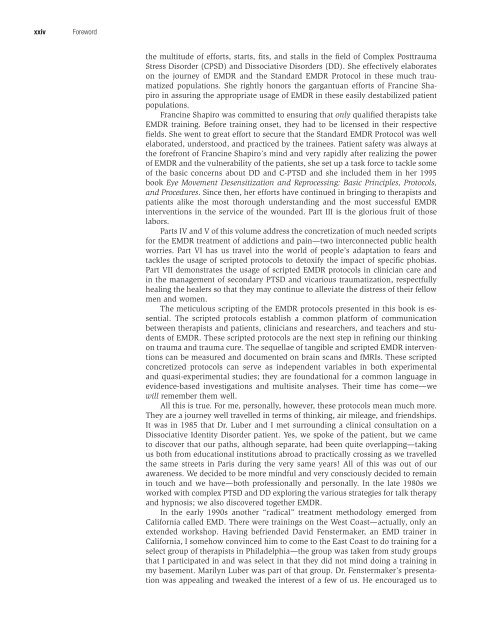(EMDR) Scripted - Springer Publishing
(EMDR) Scripted - Springer Publishing
(EMDR) Scripted - Springer Publishing
You also want an ePaper? Increase the reach of your titles
YUMPU automatically turns print PDFs into web optimized ePapers that Google loves.
xxiv<br />
Foreword<br />
the multitude of efforts, starts, fits, and stalls in the field of Complex Posttrauma<br />
Stress Disorder (CPSD) and Dissociative Disorders (DD). She effectively elaborates<br />
on the journey of <strong>EMDR</strong> and the Standard <strong>EMDR</strong> Protocol in these much traumatized<br />
populations. She rightly honors the gargantuan efforts of Francine Shapiro<br />
in assuring the appropriate usage of <strong>EMDR</strong> in these easily destabilized patient<br />
populations.<br />
Francine Shapiro was committed to ensuring that only qualified therapists take<br />
<strong>EMDR</strong> training. Before training onset, they had to be licensed in their respective<br />
fields. She went to great effort to secure that the Standard <strong>EMDR</strong> Protocol was well<br />
elaborated, understood, and practiced by the trainees. Patient safety was always at<br />
the forefront of Francine Shapiro’s mind and very rapidly after realizing the power<br />
of <strong>EMDR</strong> and the vulnerability of the patients, she set up a task force to tackle some<br />
of the basic concerns about DD and C-PTSD and she included them in her 1995<br />
book Eye Movement Desensitization and Reprocessing: Basic Principles, Protocols,<br />
and Procedures. Since then, her efforts have continued in bringing to therapists and<br />
patients alike the most thorough understanding and the most successful <strong>EMDR</strong><br />
interventions in the service of the wounded. Part III is the glorious fruit of those<br />
labors.<br />
Parts IV and V of this volume address the concretization of much needed scripts<br />
for the <strong>EMDR</strong> treatment of addictions and pain—two interconnected public health<br />
worries. Part VI has us travel into the world of people’s adaptation to fears and<br />
tackles the usage of scripted protocols to detoxify the impact of specific phobias.<br />
Part VII demonstrates the usage of scripted <strong>EMDR</strong> protocols in clinician care and<br />
in the management of secondary PTSD and vicarious traumatization, respectfully<br />
healing the healers so that they may continue to alleviate the distress of their fellow<br />
men and women.<br />
The meticulous scripting of the <strong>EMDR</strong> protocols presented in this book is essential.<br />
The scripted protocols establish a common platform of communication<br />
between therapists and patients, clinicians and researchers, and teachers and students<br />
of <strong>EMDR</strong>. These scripted protocols are the next step in refining our thinking<br />
on trauma and trauma cure. The sequellae of tangible and scripted <strong>EMDR</strong> interventions<br />
can be measured and documented on brain scans and fMRIs. These scripted<br />
concretized protocols can serve as independent variables in both experimental<br />
and quasi-experimental studies; they are foundational for a common language in<br />
evidence-based investigations and multisite analyses. Their time has come—we<br />
will remember them well.<br />
All this is true. For me, personally, however, these protocols mean much more.<br />
They are a journey well travelled in terms of thinking, air mileage, and friendships.<br />
It was in 1985 that Dr. Luber and I met surrounding a clinical consultation on a<br />
Dissociative Identity Disorder patient. Yes, we spoke of the patient, but we came<br />
to discover that our paths, although separate, had been quite overlapping—taking<br />
us both from educational institutions abroad to practically crossing as we travelled<br />
the same streets in Paris during the very same years! All of this was out of our<br />
awareness. We decided to be more mindful and very consciously decided to remain<br />
in touch and we have—both professionally and personally. In the late 1980s we<br />
worked with complex PTSD and DD exploring the various strategies for talk therapy<br />
and hypnosis; we also discovered together <strong>EMDR</strong>.<br />
In the early 1990s another “radical” treatment methodology emerged from<br />
California called EMD. There were trainings on the West Coast—actually, only an<br />
extended workshop. Having befriended David Fenstermaker, an EMD trainer in<br />
California, I somehow convinced him to come to the East Coast to do training for a<br />
select group of therapists in Philadelphia—the group was taken from study groups<br />
that I participated in and was select in that they did not mind doing a training in<br />
my basement. Marilyn Luber was part of that group. Dr. Fenstermaker’s presentation<br />
was appealing and tweaked the interest of a few of us. He encouraged us to

















